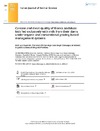Please use this identifier to cite or link to this item:
https://accedacris.ulpgc.es/jspui/handle/10553/69976
| DC Field | Value | Language |
|---|---|---|
| dc.contributor.author | Guzmán, José Luis | en_US |
| dc.contributor.author | De-La-Vega, Francisco | en_US |
| dc.contributor.author | Angel Zarazaga, Luis | en_US |
| dc.contributor.author | Argüello Henríquez, Anastasio | en_US |
| dc.contributor.author | Delgado-Pertíñez, Manuel | en_US |
| dc.date.accessioned | 2020-02-05T12:51:40Z | - |
| dc.date.available | 2020-02-05T12:51:40Z | - |
| dc.date.issued | 2019 | en_US |
| dc.identifier.issn | 1594-4077 | en_US |
| dc.identifier.other | Scopus | - |
| dc.identifier.uri | https://accedacris.ulpgc.es/handle/10553/69976 | - |
| dc.description.abstract | The number of organic farms is growing, but switching from conventional to organic production requires farms continue to produce high quality products. This study compares the carcase and meat quality of Blanca Andaluza goat suckling kids raised under organic and conventional grazing-based stock raising production systems. Twenty-four twin kids (12 males, 12 females) were selected from representative farms of each system. Body weight, dressing percentage, carcase linear measurements, non-carcase components, primary carcase and minor cuts, tissue composition, chemical composition and rheological variables, pH and colorimetric variables, were examined. No significant differences were seen between the production systems or sex with respect to most of the variables studied. However, some non-carcase components and colorimetric variables were affected, with the organic kids' meat returning lower values for lightness, yellow index, chroma and Hue angle. Indeed, some of the meat colour variables examined easily discriminated between the animals raised under the different production systems. These results show that conventional grazing–based farms raising these goats could easily turn to organic production without carcase or meat quality being affected.Highlights Organic farms are growing in number. The transformation to organic kid-raising is easy, with meat quality unaffected. These results are of interest with respect to the viability of conventional goat farms. | en_US |
| dc.language | eng | en_US |
| dc.relation.ispartof | Italian Journal of Animal Science | en_US |
| dc.source | Italian Journal of Animal Science [ISSN 1594-4077], v. 18 (1), p. 1186-1191 | en_US |
| dc.subject | 330921 Alimentos proteínicos | en_US |
| dc.subject.other | Goat Kid | en_US |
| dc.subject.other | Organic | en_US |
| dc.subject.other | Production System | en_US |
| dc.subject.other | Sex | en_US |
| dc.title | Carcase and meat quality of Blanca Andaluza kids fed exclusively with milk from their dams under organic and conventional grazing-based management systems | en_US |
| dc.type | info:eu-repo/semantics/Article | en_US |
| dc.type | Article | en_US |
| dc.identifier.doi | 10.1080/1828051X.2019.1638317 | |
| dc.identifier.scopus | 85069508394 | - |
| dc.identifier.isi | 000475333000001 | |
| dc.contributor.authorscopusid | 55667552800 | - |
| dc.contributor.authorscopusid | 55843825600 | - |
| dc.contributor.authorscopusid | 57210125302 | - |
| dc.contributor.authorscopusid | 6701710018 | - |
| dc.contributor.authorscopusid | 6507900281 | - |
| dc.description.lastpage | 1191 | en_US |
| dc.identifier.issue | 1 | - |
| dc.description.firstpage | 1186 | en_US |
| dc.relation.volume | 18 | en_US |
| dc.investigacion | Ciencias de la Salud | en_US |
| dc.type2 | Artículo | en_US |
| dc.contributor.daisngid | 916878 | |
| dc.contributor.daisngid | 27869139 | |
| dc.contributor.daisngid | 31493195 | |
| dc.contributor.daisngid | 298051 | |
| dc.contributor.daisngid | 2187735 | |
| dc.utils.revision | Sí | en_US |
| dc.contributor.wosstandard | WOS:Guzman, JL | |
| dc.contributor.wosstandard | WOS:De-La-Vega, F | |
| dc.contributor.wosstandard | WOS:Zarazaga, LA | |
| dc.contributor.wosstandard | WOS:Arguello, A | |
| dc.contributor.wosstandard | WOS:Delgado-Pertinez, M | |
| dc.date.coverdate | Enero 2019 | |
| dc.identifier.ulpgc | Sí | es |
| dc.description.sjr | 0,534 | |
| dc.description.jcr | 1,805 | |
| dc.description.sjrq | Q2 | |
| dc.description.jcrq | Q1 | |
| dc.description.scie | SCIE | |
| item.fulltext | Con texto completo | - |
| item.grantfulltext | open | - |
| crisitem.author.dept | GIR IUSA-ONEHEALTH 4. Producción y Biotecnología Animal | - |
| crisitem.author.dept | IU de Sanidad Animal y Seguridad Alimentaria | - |
| crisitem.author.dept | Departamento de Patología Animal, Producción Animal, Bromatología y Tecnología de Los Alimentos | - |
| crisitem.author.orcid | 0000-0002-4426-0678 | - |
| crisitem.author.parentorg | IU de Sanidad Animal y Seguridad Alimentaria | - |
| crisitem.author.fullName | Argüello Henríquez, Anastasio | - |
| Appears in Collections: | Artículos | |
SCOPUSTM
Citations
6
checked on Jun 8, 2025
WEB OF SCIENCETM
Citations
6
checked on Jun 8, 2025
Page view(s)
69
checked on Feb 24, 2024
Download(s)
84
checked on Feb 24, 2024
Google ScholarTM
Check
Altmetric
Share
Export metadata
Items in accedaCRIS are protected by copyright, with all rights reserved, unless otherwise indicated.
